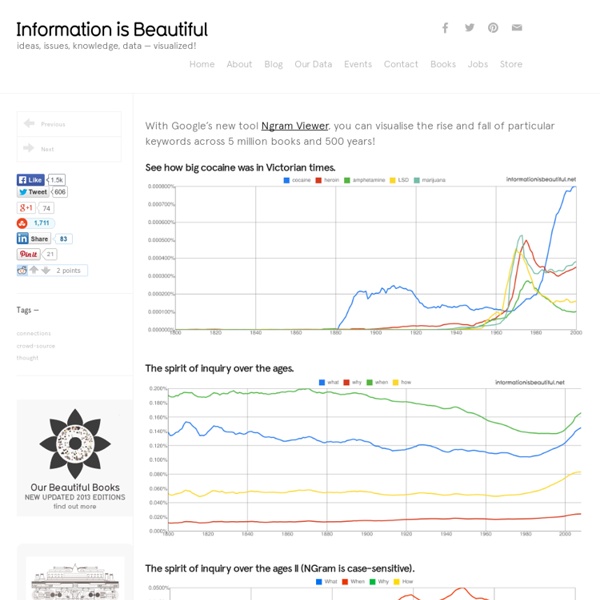Google NGram Experiments
With Google’s new tool Ngram Viewer, you can visualise the rise and fall of particular keywords across 5 million books and 500 years! See how big cocaine was in Victorian times. The spirit of inquiry over the ages. The spirit of inquiry over the ages II (NGram is case-sensitive). The Battle Of The Brains What happened around 1700??? Age-old debates (by Andy, James Rooney, Nick, Bidzubido, Jacqui,Gary,Stefan Lasiewski,Mark) Got any more?
Google
Free MyCokeRewards Codes (XI) | Asdfhj.com
Free MyCokeRewards Codes (XII) about 2 years ago - 841 comments Wow! It’s already 2012, and we’re back with another year of MyCokeRewards, and another year of sharing Coke codes with the nice little community we’ve built here! McDonald’s Monopoly 2011 – Free Codes! about 2 years ago - 330 comments McDonald’s Monopoly is back for 2011, and you know what that means around here… more free codes for everyone! Lean Cuisine Delicious Rewards – Free codes! about 2 years ago - 50 comments Lean Cuisine seems to have joined the trend of code-based customer loyalty programs with their “Delicious Rewards” program! Free Dr Pepper “Every Bottle Wins” codes about 2 years ago - 316 comments This year, Dr Pepper has a new game on codes and cups: Every Bottle Wins – where you can redeem your codes for various items, including EA games downloadable content. Free MyCokeRewards Codes (X) about 3 years ago - 479 comments Welcome to the best place on the web to snag or share free MyCokeRewards codes! MyCokeRewards FAQ
Methods | Futugene Oy - Love to Grow
NeuroLeadership – Transforming thinking & performance The methodology brings hard science to the art of improving human performance. NeuroLeadership®Group is a global human performance consultancy, drawing from the latest findings in neuroscience. HeartMath – Building coherence and resilience The Institute of HeartMath® has created a medically and scientifically validated system for enhanced coherence and resilience. Measuring the Success of Coaching High Impact coaching can significantly contribute to success journey of individuals and organizations. Play and applied improvisation Applied improvisation is a toolbox of various exercises, which can be adapted as energizers or excercises to demonstrate some real life situation.
The place for people to share things they’re willing to do for $5
Jon Kabat-Zinn
Jon Kabat-Zinn Jon Kabat-Zinn (born Kabat on June 5, 1944) is Professor of Medicine Emeritus and creator of the Stress Reduction Clinic and the Center for Mindfulness in Medicine, Health Care, and Society at the University of Massachusetts Medical School. Kabat-Zinn was a student of Zen Master Seung Sahn and a founding member of Cambridge Zen Center. His practice of yoga and studies with Buddhist teachers led him to integrate their teachings with those of Western science. Life and work[edit] Kabat-Zinn was born in 1944, to Elvin Kabat, a biomedical scientist, and Sally Kabat, a painter. Kabat-Zinn was born Jewish but has stated that his beliefs growing up were a fusion of science and art.[2] Career[edit] Thich Nhat Hanh[3] has brought mindfulness to the attention of Westerners. Kabat-Zinn is the creator and former Executive Director of the Center for Mindfulness in Medicine, Health Care, and Society at the University of Massachusetts Medical School. Personal life[edit] Works[edit]
Free & Cheap Events & Things to Do in the San Francisco Bay Area
Related:
Related:



